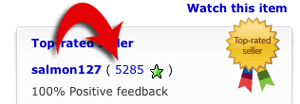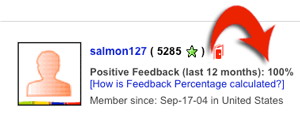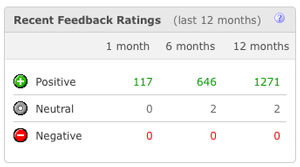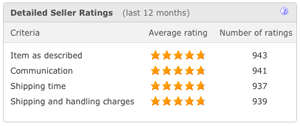| Most-Watched Items | eBay Bidding Tips | Evaluating Sellers | How To Shop Like a Pro on eBay |
This site contains affiliate links for which I may be compensated
Tips to Ensure That You Bid and Buy from Good Sellers on eBay
Tip
Look for sellers and items that are located in the United States. You will minimize or avoid language difficulties, reduce the likelihood of receiving foreign knockoffs of trademarked brands, and avoid high shipping costs to return the item if it's broken, damaged, or significantly not as described.
To help keep your eBay buying positive, our handy advanced eBay search defaults to showing you only items located in the U.S.
With all the buyer protections that eBay has instituted in recent years, eBayers have a lot less worries about dishonest sellers. If you pay $300 for an iPhone and the seller sends you a picture of an iPhone, or sends you a broken iPhone, you will be able to get your money back, provided you follow eBay's procedures for filing a dispute.
But your eBaying experiences will be a lot more pleasant if you avoid sellers like that. Nobody wants to have to file disputes and submit evidence and wait for their money to be returned. You'd much rather buy from good, honest sellers who send the item you bought, promptly and in the condition it was listed in the auction, and who will take care of any problems for you without forcing you to file disputes with eBay or PayPal.
The single most important thing you can do is look at the seller's feedback — his total feedback score, his positive feedback percentage, his "Detailed Seller Ratings" (DSRs), and feedback comments he has both received and left. On every item listing page, over at the right side of the page, you'll see a box where the seller is identified (by his eBay user ID). Next to his username is a number in parentheses. That number is the seller's feedback score, and if you click on that number, you'll be taken to his feedback page.
Let's take those one at a time to see what they tell you. I'm going to use the example of a seller whose id is salmon127, because he's a great seller that I've bought from who provides wonderful customer service. Here is salmon127's feedback page.
Total Feedback Score

On the item listing page, look for the number next to the seller's name to find his feedback score, and click that number to see his full feedback profile.
The number next to the seller's eBay id is the total feedback score. This tells you how many feedbacks he has received from other buyers and/or sellers. A feedback score in the thousands, or tens of thousands, tells you that this is a very experienced eBayer. A high total feedback score tells you that you're dealing with a seasoned seller who has a proven track record. At the time of this writing, salmon127 has 5,285 feedbacks. Further down the page, I see that he has received 5,414 feedbacks. These numbers are different because eBay counts multiple feedbacks in the same week as one, so salmon127's total feedbacks received are higher than his official total feedback score. But either way, I can tell he's sold a good bit of stuff on eBay.

On the seller's feedback page, you'll see his positive feedback percent, and below that, a line telling you how long he's been a member of eBay.
Tip: You shouldn't necessarily feel that you need to avoid sellers with a low number of feedbacks. But when buying items that have a higher rate of fraud and other problems, it's probably better to avoid the newbies. You probably shouldn't buy an iPod, for example, from a seller with just a few feedbacks. Sure, go ahead and buy a $10 iPod case from that newbie seller, but buy your iPod from someone who has been around a while and has a proven track record.
Also, pay attention to the number of feedbacks received as a seller vs. the number received as a buyer. A buyer with 150 buyer feedbacks who becomes a seller has no sales under their belt. They may not offer a quality product, they may know nothing about shipping items safely, or they may even be a scammer. But someone with 150 feedbacks as a seller, if their positive feedback percentage is good, along with their DSRs and comments from buyers, might just be a great seller who happens to be relatively new on eBay.
Another thing to watch for is what kinds of items they received their feedback for. Many new sellers will sell a lot of cheap items for $0.99 to build up their feedback, then suddenly start listing expensive iPods and other high-end electronics. If you scroll down the feedback page to where the feedback comments are shown, you'll see, along with the comments, the item listed, the price paid, and the seller, along with a link to the item listing. (For sales that haven't aged off, that is.) Particularly for sellers with low feedback scores, take a few moments to scan those. If the seller's feedbacks are all for cheap items, and he's suddenly offering expensive electronics for sale, you might want to step back and think hard about whether you want to bid on that item. You're probably better off looking for the same item from a seller who has a track record selling that kind of item.
Positive Feedback Percentage

Check the number of negs and neutrals the seller has received in the past 1 month, 6 months and 12 months to get a feel for their recent performance as a seller.
Let's go back to the top of the seller's feedback page. Below the seller's user ID, you'll see the seller's positive feedback percentage just below his user ID, and below that a box with the seller's feedback ratings from the past 12 months. My example seller, salmon127, has positive feedback of 100%. In the past 12 months, he's had 1,271 postive feedbacks, 2 neutrals, and zero negatives. (The feedback percentage is based on the seller's positive feedback in the past 12 months, while the feedback score is a lifetime total.) These numbers tell me that, overall, his customers are highly satisified with his products, prices, and service.
Very very few sellers manage to sell a lot on eBay without receiving some negatives and neutrals. Even great sellers can make honest mistakes that they get "negged" for, and even a perfect seller (if there were such a thing) could have a few unreasonable buyers who never give anybody a positive. So don't let a few negative or neutral feedbacks scare you away from a seller. But a good seller should have at least a 99% or better positive feedback percentage. For inexpensive items, you might be willing to risk a few dollars with a 97% or 98% seller, but for anything that's expensive or that's prone to fraud, you should definitely look for at least a 99% positive feedback percentage. 99.9% or 100% would be even better.
In the box that breaks down the feedback positives, negs and neutrals by 1 month, 6 months and 12 months, you should pay attention to when the seller received his negs or neutrals. A seller who received a lot of negs between 6 and 12 months ago, but whose 1 month and 6 month ratings are stellar, may have had a problem in the past with his service or merchandise that he has addressed. A seller with a number of 1 month negatives (or neutrals) may be going through a bad patch currently, and despite a long and overall positive track record, he may not be the best seller to buy from at this time.
My example seller, salmon127, has no negatives in the past 12 months, and only 2 neutrals, both more than 6 months old. His track record overall is excellent, and his recent track record is great.
Detailed Seller Ratings (DSRs)

Check the seller's DSRs (Detailed Seller Ratings) to see what his buyers think of his accuracy in describing items, communication, shipping time, and shipping and handling charges.
Now we'll take a look at the seller's DSRs. These are the stars in the box to the right of the feedback ratings. Every buyer who leaves feedback has a chance to rate the seller on "item as described," "communication," "shipping time," and "shipping and handling charges" on a scale of 1 to 5. You can hover your mouse over each star to see the seller's total average DSR score in each of these areas. A good seller should have 4.8s or 4.9s on all of the stars.
Sellers often complain that their DSRs for shipping time and shipping and handling charges are rated unfairly by buyers who don't fully understand what they're rating. The shipping time star is supposed to rate the seller's promptness in getting the package into the hands of the post office or other shipper, but buyers often ding a seller's shipping time star if the post office was slow in delivering their package. Likewise, while buyers technically agree to the seller's shipping and handling charges at the time they bought or bid on the item, that doesn't mean they're happy with those charges. Buyers often misunderestimate the costs of packaging and shipping an item, and they ding the seller's star for that cost, even if the seller actually took a loss on the shipping cost. So bear in mind that for many sellers, those scores might be lower than the first two stars through no fault of the seller.
In general, be wary of sellers with unusually low DSR ratings in one or more areas. A slightly low shipping time star (such as 4.7) may simply indicate that buyers misunderstand what they're rating, but a very low score — e.g., 4.1 or 3.5 — probably indicates a seller who is slow to get his packages out. If you buy from such a seller, don't be surprised if he takes a while to get your item in the mail.
My example seller, salmon127, currently has 4.9s on all of his stars. Nothing to worry about there. If I were buying a very expensive item for hundreds (or thousands) of dollars, I might look for a seller with 5s at least in the first two stars, but for your run-of-the-mill everyday purchase on eBay, 4.9s are excellent.
Special Considerations for Low-Feedback Sellers
Remember that for a seller with a low total feedback score, poor ratings from a very small number of buyers can seriously affect his feedback percentage and his DSR scores. Keep that in mind when evaluating sellers, and check their feedback comments more closely. They may not be a bad seller at all, but ran into a few bad buyers who have seriously damaged their seller ratings.
Feedback Comments
There are 2 important components in looking at feedback comments: The comments left for the seller by his buyers (the "Feedback as a seller" tab), and the comments left by the seller (the "Feedback left for others" tab).
Feedback Comments Received

Below the seller's feedback ratings, you'll see 4 tabs, one each for feedback received as a seller, feedback received as a buyer, all feedback received, and feedback left for others. Click the different tabs to see the different feedbacks received and left.
The comments the seller has received from buyers tell you what the buyers thought about the transaction. Regardless of whether the feedback is positive, negative or neutral, if you see a lot of feedback comments about slow shipping, he's probably a slow shipper. If you see a lot of feedback comments about item condition, he may not be very careful about describing and photographing his items well.
Feedback Comments Left
Feedback and feedback comments left by the seller for his buyers is a different matter, and more difficult to judge. Since early 2008, sellers have not been permitted to leave a neutral or negative feedback for a buyer, nor are they permitted to leave a positive feedback accompanied by a negative comment. So it's harder to judge a seller by his feedback left for others. One thing you can look at are the seller's "replies" to the buyer's feedback. The seller's replies appear on the same page as the feedback left by the buyer for the seller. Sellers are permitted to leave negative comments in a reply to the feedback left by the buyer. What you particularly want to look for are transactions where there was a problem. When buyers have complaints, how does the seller respond? How does the seller handle problems? Does he call his buyer names in the feedback reply? Or do the seller's feedback replies sound calm and professional in the face of unreasonable buyer demands? Does he go out of his way to make his customers happy? Or does he respond with malice and spite?
For sellers who have been selling on eBay since prior to 2008, though, you can learn a lot by looking at the feedbacks and feedback comments left by the seller for his buyers for older transactions. First click the "Feedback left for others" tab, then scroll down and click through the page numbers at the bottom to access older feedbacks until you get to transactions that took place prior to May 2008. Now start looking at the feedbacks and comments left by the seller for his buyers. You'll look for the same type of things you look for in the seller's feedback replies. Back in eBay's Wild West days, feedback left by sellers sometimes revealed them to be terribly unprofessional in their dealings with buyers.
The Secret Weapon for Checking Feedback

At Toolhaus.org, simply enter the seller's eBay user ID in the box and click either the "Received by" or "Left by" button to see all the seller's negative and neutral feedback received or left.
By now you've probably noticed that in looking through the feedbacks left for a high-volume seller, there are lots and lots of positive feedbacks, and it's hard to find the negatives buried amid all the positives. What you really want to know about a seller, though, is how he handles problems, and the best way to do that is to look at the negatives.
eBay does not provide us with an easy way to look at just the negatives and neutrals received by or left by a seller, but toolhaus.org does. Simply go to Toolhaus.org and enter the seller's eBay user ID, then click either the "Received by" or the "Left by" button to see all the negs and neutrals together.
You want to be careful in using Toolhaus.org, because a long-time, high-volume seller will, over time, receive a fairly high number of negs and neutrals. Gathering these together all in one place, without the softening effect of all the positives, is likely to make the seller look really bad. Keep in mind, you've already checked the seller's positive feedback percentage, which is somewhere in the neighborhood of 99.8%, so you know that the vast majority of his transactions result in positive feedback. That's not what you're using Toolhaus for. If the seller didn't have a good overall track record to begin with, you wouldn't even bother with Toolhaus.
What you want to look for on Toolhaus.org are signs of continuing problems. If, every time a seller receives a neg from a buyer, he denies any responsibility and lays all the blame on the buyer, you would know not to expect great customer service from that seller. If, every time a package arrives with damage from shipping, the seller attempts to wash his hands of responsibility, you know that if your item has shipping damage, you'll have to file with eBay/PayPal to force the seller to refund. When a transaction goes smoothly, it's easy for both parties to leave each other positive feedback. It's when problems occur or buyers complain that you see a seller's true colors.
If the seller always responds calmly and professionally, and appears to do everything within reason to make his buyers happy, that will be revealed in the negs and neutrals. You'll learn quickly to spot the transactions where the seller was at fault but made good on it, as well as the transactions where the buyer was simply being unreasonable. And you'll soon be able to spot the problem sellers from a mile away, so that you can steer clear of them.
When I use Toolhaus.org to check salmon127's neg and neutral feedback received and neg and neutral feedback left, I see a few complaints about item condition, along with a smattering of other minor problems. This is from a selling career on eBay that goes back to early 2005, out of more than 5,000 total feedbacks received. I see that the "negs and neuts" received by salmon127 were mostly left by buyers who didn't contact him prior to leaving feedback, and who did not give him a chance to make things right. I also see salmon127 responding calmly and factually to those bad, probably unfair, feedbacks. I'm reassured that, while it's unlikely that I'll have a problem with this seller, if I do have a problem, it's likely that I can contact him and he'll do what he can to make things right.
Summary
Always check the seller's feedback before placing your bid or clicking Buy It Now. If you stumble across an auction in its last few minutes, and you don't have time to check the seller's feedback, then pass by that auction. It's likely that the item you want will be available again from that seller or others. The time you don't check the seller's feedback first is likely to be the time that you end up buying from an awful seller who turns your transaction into a nightmare. By taking the time to check the seller's feedback before bidding, you can be assured that you're buying from an honest, ethical seller who will treat you right.